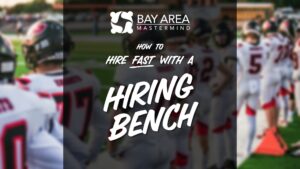
The push-ups were worth it. Ryan Crownholm’s commanding officer looked across the desk and locked eyes. “There’s a career here for you…” he said flatly. “There’s nothing outside of the military for you.” Ryan smiled and replied “Look me up when you get out and I’ll have a job for you!”
Blowing up airplanes for the military with stinger missiles doesn’t provide a lot of job opportunities, though. There’s not much need for that in the private sector. So when Ryan returned home, he tried to find a job, but… they all sucked.
So perhaps he needed to start his own business?
But first, he wanted to get through school and start making some money with any kind of job.
Out of the Frying Pan and into a Fire
Shortly after moving home, Ryan was busy applying to school and trying to find a job.
Taking a break from the grind one evening, he went off to his happy place: the gym. After getting a good workout in and setting his head straight, he returned home to find six fire trucks at his house.
The entire house had burned to the ground.
Everything was gone.
Insurance did pay for a hotel for a short while, but when that ran out, it was bouncing between hotels, friends couches, and cars while trying to hold down a job in a restaurant and go to school.
College and Jobs Aren’t For Everyone
Ryan really did try the whole job thing. He started as a server, then got promoted to bouncer for taco tuesdays. Next he was working behind the bar and became the bartender, then moved on to manager. It was a good few years while going to school, paid for by the government.
In the end, though, despite graduating with a degree in Business and Economics, he didn’t see a whole lot of value in college.
And as for those jobs? He likes to work at his own pace and at his own rhythm and a regular job doesn’t support that.
“I might push hard for 3 months, and then travel for 3 months in South America or Asia. That doesn’t work in a job.”
Launching a Real Business and Scaling Fast
His first foray into running his own business was just putting a trailer on his truck. He used money from his job to buy the trailer and the truck and started hauling junk.
“This was before all the big brands you know of today. I was the big guy in the Bay Area.”
Before long, a friend needed a job, so he bought another truck. And then he bought his first dump truck with a $14k loan.
Pretty quickly, he had 10 trucks and 15 employees. And things were scaling fast.
Do Your Customers Know Best?
The trucks got bigger and better and had got even more licensing, for example a D63 contractors license to get into more demolition and eventually a Class A general engineering license
This in turn grew the complexity of the business – at the expense of growing the actual business.
“I was following the needs of my customers. In retrospect, it’s not always the best decision to do that.”
He was adding more types of specialized trucks and equipment which in turn needed more specialized employees.
That’s expensive, complicated, less profitable, and… less of a simple, repeatable, or scalable business.
More on the power of simple and repeatable in a bit…
Leading From the Front
Being a military guy, Ryan followed the military model of “leading from the front”. You don’t just tell your employees what to do; you get out there on the front lines and get the work done with them.
One summer morning, Ryan went to the office early like he always did, hooked up a bobcat front loader on the back of a trailer to his truck, and drove to the job site.
Once on site, he parked, got out to start working with the crew, and then stepped out to take a phone call.
Mid call, Ryan looks up and sees his truck rolling down the hill… directly towards him.
Next thing he knows, the truck ran him over and dragged him down the street with him underneath it. When the truck at long last came to a stop, he pulled himself out from under the truck to find his femur sticking out of his jeans and blood everywhere.
The ambulance showed up and took him to the trauma center and started to put him back together. It was a big job with two broken legs, broken ribs, punctured lungs, shattered shoulder, blood loss, and more.
He wasn’t going to make it to the front lines that afternoon. Or the next morning. Or anytime soon.
But he still had a business to run.
Unfortunately, the only thing he used to grow this business from nothing to something – his physicality – was lost.
Growing a Business from a Hospital Bed
Ryan doesn’t give up.
So he had to rethink how he was going to run the business.
What were all the things he did on a regular basis?
Well, that was permits, labor, payroll, and more. And he had to remove himself from all of those.
Each time he replaced himself in one of the roles in the business, his company did just a little better. As he continued the process, that’s when the company really started to hum.
He discovered the niche of swimming pool removal. It’s a complex process to do it right – but it’s a very repeatable process. And systems are what you use to grow a business!
In fact, he doubled his business every year up to 300 pool removals a year! And these jobs had a 70% profit margin on each job!
“Had that accident not happened, I’d be the cranky guy in a pickup truck still running jobs, yelling at my crew.”
The Double Edged Sword of Total Responsibility
Now out of the hospital with his business growing and needing less of him day to day, Ryan faced an onslaught of all new challenges.
One day, he was driving down the highway, mulling over the economic downturn, the softening housing market, and the impact that was all having on his company finances.
His phone rang and he saw it was one of his crew members calling him. Ryan picked up the call on speaker phone to see what his team needed.
The crew was at a job site and… they forgot to chock the tires on one of the trucks and the truck… had rolled into the customer’s house.
Ryan had to pull off the side of the road and just scream out loud for a moment. He couldn’t handle any more bad news. What else could he do but just scream out loud?
“Maybe I should just go work for someone else” he thought. Then the responsibility for all of this wouldn’t rest with him.
“All you can do is push. I just had to get to the job site”
As the business owner, everything is our fault. From the finances of the company all the way down to the trucks that roll into houses.
It’s easy to just get frustrated, and scream, and blame, but… once you take responsibility… it’s freeing, and allows you to start fixing things.
In this case, there should have been a better system and training for chocking the tires on trucks.
This level of total responsibility isn’t for everyone. And it’s not easy. But entrepreneurship isn’t for everyone either, and it isn’t always easy.
“Entrepreneurship should be for the select weirdos. Now it’s promoted for everyone.”
Setting the Team up for Success
Before trying to find the right people for your team, you need to have the right systems in place for them.
To create the right system, you need to understand the job. Then you can make a great system. And then you can hire a great person for that great system.
But do you want layers upon layers of management?
Ryan runs a very flat company and doesn’t want to manage people. During the hiring process, he makes it clear from the start that he doesn’t want to manage them. He needs team members who take initiative and solve problems on their own without him needing to be their point of contact.
“I learned a lot from Bay Area Mastermind on how to hire. For example, get the biggest pool of qualified candidates possible and go through multiple rounds of interviews. Hire your top candidates for small test jobs. And then look to see how they communicate during their test jobs and how quickly they can get it done.”
Measuring Success
So how do you know how well your team is doing?
“My ultimate metric is profitability. I could care less about top line, headcount, valuations, or fundraising. I want to know how much profit was made and in how much time. Specifically, in how much Ryan Time. Then I can look at how much I am making as the business owner.”
On a more granular basis, however, there are a few key metrics that Ryan reviews. These are simple things like conversion rates, traffic, ad spend, customer ratings, turnaround time, etc. He even has a daily email with all of those numbers.
You can build a self managed business, but if you don’t have “triggers” for when key metrics vary too far, you’ll be out of business.
If something falls off track, the person responsible needs to explain it and get it back on track.
Without triggers, you can’t take action. For example, he had a phone system. Due to a technical glitch in the system, if there was a voicemail being left, the second call that went to voicemail was falling over to some other system. His staff didn’t alert him to the fact calls weren’t being returned until a customer alerted them to the issue because nobody knew about those other voicemails. Logging into the secondary system, Ryan found 400 voicemails that never got returned. That kind of issue would have come up in customer ratings.
Now, his team does chat and voice audits weekly to make sure the team is performing. If a rating goes down, he can see what retraining is needed.
Balancing Hustle and Anti-Hustle
Ryan Crownholm, who happens to be the author of “The Hustle Trap” isn’t actually 100% anti-hustle…
“I’m not pro – or anti – hustle. I’m right in the middle. You have to hustle on the right things. The ‘If you’re not busy, you’re not moving forward’ mindset is a fallacy. Nobody got their next billion dollar idea while sitting at the computer pounding out emails.”
With the right people and systems in place, Ryan can focus on his health, his family, and travel. And his businesses are built to support that.
“I have about 40 full time people working for me. That’s 1,600 hours a week operating on my behalf. Even if I put in 40 hours of work… Would that make a dent in the business? The thing those 40 people can’t do is the work on the vision of the business. Outside consultants don’t know anything about your business. FREE yourself to be your own consultant. You’re the best visionary and consultant you could ever have.”
Having the freedom from your business not only provides financial freedom but time freedom. That new found time lets you see opportunities – both within your business and outside of your business in the form of new businesses, investments, and deals.
And that’s exactly how Ryan has been spending his time: Spinning up new businesses, mentoring new businesses, and investing in businesses.



Lessons Learned by Ryan Crownholm
- Take extreme and complete ownership over everything that happens to you and your business. Once you do that, it’s empowering and freeing.
- Focus on repeatable things that can be scalable. That’s how you build a scalable business. Avoid chasing after so many shiny objects. It can be boring to find simple things that work, but it lets you scale and step back. One of Ryan’s side businesses is an online service that sells one thing and doesn’t involve any of his time. They’ve serviced 70,000 customers and have over 7,000 5 star reviews. It’s boring and unglamorous, but it’s simple and scalable.
- Keep your burn rate low. Ryan buys his cars, motorcycles, etc all cash. He buys his houses with 60%+ cash down. That keeps his cash flow needs low (and in turn his Freedom Number high!)
- Get your FU Money. With enough money in the bank, you don’t have to worry about a paycheck from an employer forcing your decisions. You can do what you want. This lets you detach your decision making from money. If someone treats his employees poorly, he’ll decline their business regardless of how much money is lost. He also doesn’t have a single customer that makes up more than 1% of his annual revenue.
- Join a Mastermind Group. “Jeremy and the Bay Area Mastermind were so impactful for me!” Surround yourself with other entrepreneurs outside of your industry. You’ll find answers to questions you didn’t know you had.
- Surround yourself with good books. And read them. And implement.



